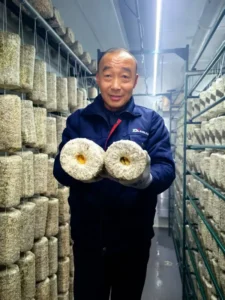In the warm and moist mushroom greenhouse, rows of mushroom logs are neatly arranged. On the dark brown surface of the logs, wood ears are quietly popping out one by one. They resemble curious little sprites, slowly emerging from the logs, growing larger and gradually unfolding. As a gentle breeze blows by, the wood ears sway lightly, as if announcing their arrival to the world, adding a touch of liveliness and vitality to the already bustling mushroom greenhouse.
The wood ears are not only a source of economic income for the farmers but also a symbol of nature’s vitality and abundance. In the early stages of growth, the wood ears are small and delicate, clinging tightly to the surface of the mushroom logs. As time passes, they absorb nutrients and moisture from the logs, gradually expanding and thickening. The edges of the wood ears curl slightly, resembling the shape of a human ear, which is also the origin of their name. Farmers need to carefully manage the temperature, humidity, and ventilation of the greenhouse to ensure the healthy growth of the wood ears.
This includes regularly spraying water to maintain humidity, opening windows for ventilation to prevent the accumulation of harmful gases, and controlling the temperature to avoid extreme heat or cold that could affect the growth of the wood ears. In addition, the growth of wood ears also requires a certain amount of light, but excessive strong light may cause them to dry out and become hard, so shading measures are often needed. After the wood ears mature, they will be harvested and dried for sale, becoming a popular ingredient in the market, widely used in various dishes.

